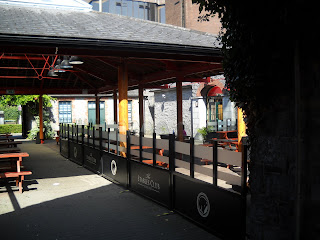Last Saturday, I decided to take a little trip to the town of Wexford (map: http://bit.ly/97sFS2). Now, if you took the time to actually look at that map and zoom out a bit, you can see that I lied when I said I took a “little” trip, seeing as how Wexford is on the other side of the country from Limerick. Truth be told, I probably spent more time on a bus or waiting for a bus than actually exploring, but I still think it was a fulfilling day (and I hope my blog entry will exemplify that).
Anyway, Wexford was founded by the good old Vikings in the 9th century, but due to its close proximity to Britain, it was one of the first places taken over by the Normans (the rulers of England at the time) in 1169. Like every other place in Ireland, it was sacked by Oliver Cromwell in the 1640s (who’s a really popular figure over here *cough*). It was center of the 1798 Rebellion against British rule in Ireland, a rebellion that backfired since the solution to it was the Act of Union in 1801 which officially made Ireland a part of the United Kingdom. But nowadays, Wexford is a nice harbor town on the Irish Sea where people like to park their boats:
Wexford is also relevant to us Americans as well since it was the birthplace of John Barry (1745-1803), a man who fought as a naval officer for the Americans in the Revolutionary War, and would be appointed by George Washington as the first head of the newly created United States Navy in 1797. As thanks, the United States government gave the town of Wexford this lovely statue of Barry in 1956, which currently stands, sword in hand, facing the harbor and, probably not coincidently, Britain (just to be on the lookout in case they try anything again):
Anyway, I wanted to come to Wexford mainly for a place called the Irish National Heritage Park, which was a good 3 km. walk from the town (the lady at the tourist office said it would be a nice walk, but failed to tell me that the last kilometer would be on a busy highway with no sidewalk). It’s basically a trail that reconstructs Irish history from the Mesolithic period nine thousand years ago to the Norman invasion of the 12th century. For example, they recreated what a typical house would have looked like for an Irish family that lived in 7000 BC:
The house is rather cozy (real estate jargon for “small”), not because they didn’t have enough materials to build a bigger one, but because people were very nomadic; they only built simple houses because they were going to move to another location at any moment. However, when traders from Britain introduced the idea of farming to Ireland around 4000 BC, people didn’t need to be nomadic anymore, and they started building bigger houses (at least the British did something helpful for the Irish!). Anyway, the further you walk down the trail, the further forward you move through time. By the first century AD, you start seeing small communities:
By the year 600, you start seeing Christian monasteries:
By 800, you see Viking towns and longships:
And by 1200, you see Norman forts and castles:
As a history geek, it was very interesting to see a lot of things that I’ve read about in boring old books reconstructed and brought to life right in front of me. I only wish I was here during the summer, because there are reenactors and everything within the different periods of time (building fires and farming and praying and dancing jigs and stuff like that). I didn’t want to bore everyone to death with what I learned here on the blog, but if you click on the link on the right side of the page labeled “Wexford Pictures,” there I’ll have pictures and explanations of many things there within the park.
Anyway, I made it back in town with just enough time to eat something and then explore the coast of the Irish Sea. No beaches with sand or anything like that, but lots of rocks and bushes (there were still lots of lovely seagulls though!). Here’s what I saw, including a somewhat-interesting sunset from the bridge:
So that was Wexford! My next destination looks to be the Cliffs of Moher next Saturday, so get all excited about that one. Also there’s a new poll, where I ask you how I can make my blog even better (sorry, providing shirtless pictures of myself is not one of the choices). As always, thanks for reading!





















































